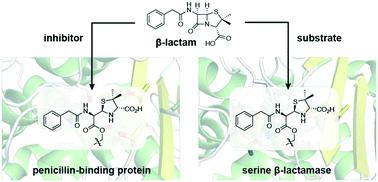当前位置:
X-MOL 学术
›
RSC Med. Chem.
›
论文详情
Our official English website, www.x-mol.net, welcomes your feedback! (Note: you will need to create a separate account there.)
β-Lactam antibiotic targets and resistance mechanisms: from covalent inhibitors to substrates
RSC Medicinal Chemistry ( IF 4.1 ) Pub Date : 2021-08-04 , DOI: 10.1039/d1md00200g Montserrat Mora-Ochomogo 1 , Christopher T Lohans 1
RSC Medicinal Chemistry ( IF 4.1 ) Pub Date : 2021-08-04 , DOI: 10.1039/d1md00200g Montserrat Mora-Ochomogo 1 , Christopher T Lohans 1
Affiliation

|
The β-lactams are the most widely used antibacterial agents worldwide. These antibiotics, a group that includes the penicillins and cephalosporins, are covalent inhibitors that target bacterial penicillin-binding proteins and disrupt peptidoglycan synthesis. Bacteria can achieve resistance to β-lactams in several ways, including the production of serine β-lactamase enzymes. While β-lactams also covalently interact with serine β-lactamases, these enzymes are capable of deacylating this complex, treating the antibiotic as a substrate. In this tutorial-style review, we provide an overview of the β-lactam antibiotics, focusing on their covalent interactions with their target proteins and resistance mechanisms. We begin by describing the structurally diverse range of β-lactam antibiotics and β-lactamase inhibitors that are currently used as therapeutics. Then, we introduce the penicillin-binding proteins, describing their functions and structures, and highlighting their interactions with β-lactam antibiotics. We next describe the classes of serine β-lactamases, exploring some of the mechanisms by which they achieve the ability to degrade β-lactams. Finally, we introduce the L,D-transpeptidases, a group of bacterial enzymes involved in peptidoglycan synthesis which are also targeted by β-lactam antibiotics. Although resistance mechanisms are now prevalent for all antibiotics in this class, past successes in antibiotic development have at least delayed this onset of resistance. The β-lactams continue to be an essential tool for the treatment of infectious disease, and recent advances (e.g., β-lactamase inhibitor development) will continue to support their future use.
中文翻译:

β-内酰胺抗生素靶点和耐药机制:从共价抑制剂到底物
β-内酰胺是全世界使用最广泛的抗菌剂。这些抗生素包括青霉素和头孢菌素,是针对细菌青霉素结合蛋白并破坏肽聚糖合成的共价抑制剂。细菌可以通过多种方式实现对 β-内酰胺的抗性,包括产生丝氨酸 β-内酰胺酶。虽然 β-内酰胺也与丝氨酸 β-内酰胺酶共价相互作用,但这些酶能够使该复合物脱酰,将抗生素作为底物。在这篇教程式的综述中,我们概述了 β-内酰胺抗生素,重点关注它们与其靶蛋白的共价相互作用以及耐药机制。我们首先描述目前用作治疗药物的结构多样的 β-内酰胺抗生素和 β-内酰胺酶抑制剂。然后,我们介绍了青霉素结合蛋白,描述了它们的功能和结构,并强调了它们与 β-内酰胺抗生素的相互作用。接下来,我们描述丝氨酸 β-内酰胺酶的类别,探索它们实现降解 β-内酰胺能力的一些机制。最后,我们介绍了L,D -转肽酶,这是一组参与肽聚糖合成的细菌酶,也是 β-内酰胺抗生素的靶标。尽管耐药机制现在在此类所有抗生素中都很普遍,但过去抗生素开发的成功至少推迟了这种耐药性的发生。β-内酰胺仍然是治疗传染病的重要工具,并且最近的进展(例如,β-内酰胺酶抑制剂的开发)将继续支持其未来的使用。
更新日期:2021-08-04
中文翻译:

β-内酰胺抗生素靶点和耐药机制:从共价抑制剂到底物
β-内酰胺是全世界使用最广泛的抗菌剂。这些抗生素包括青霉素和头孢菌素,是针对细菌青霉素结合蛋白并破坏肽聚糖合成的共价抑制剂。细菌可以通过多种方式实现对 β-内酰胺的抗性,包括产生丝氨酸 β-内酰胺酶。虽然 β-内酰胺也与丝氨酸 β-内酰胺酶共价相互作用,但这些酶能够使该复合物脱酰,将抗生素作为底物。在这篇教程式的综述中,我们概述了 β-内酰胺抗生素,重点关注它们与其靶蛋白的共价相互作用以及耐药机制。我们首先描述目前用作治疗药物的结构多样的 β-内酰胺抗生素和 β-内酰胺酶抑制剂。然后,我们介绍了青霉素结合蛋白,描述了它们的功能和结构,并强调了它们与 β-内酰胺抗生素的相互作用。接下来,我们描述丝氨酸 β-内酰胺酶的类别,探索它们实现降解 β-内酰胺能力的一些机制。最后,我们介绍了L,D -转肽酶,这是一组参与肽聚糖合成的细菌酶,也是 β-内酰胺抗生素的靶标。尽管耐药机制现在在此类所有抗生素中都很普遍,但过去抗生素开发的成功至少推迟了这种耐药性的发生。β-内酰胺仍然是治疗传染病的重要工具,并且最近的进展(例如,β-内酰胺酶抑制剂的开发)将继续支持其未来的使用。



























 京公网安备 11010802027423号
京公网安备 11010802027423号